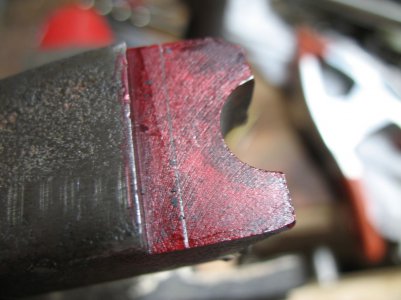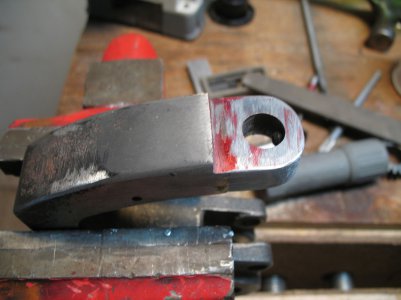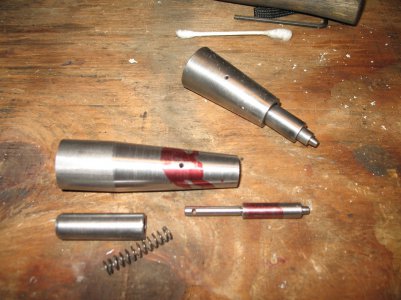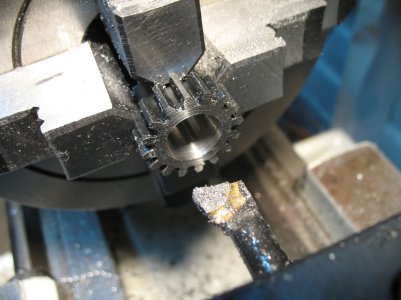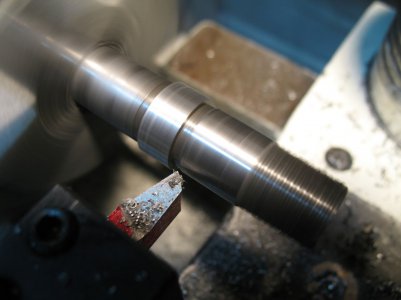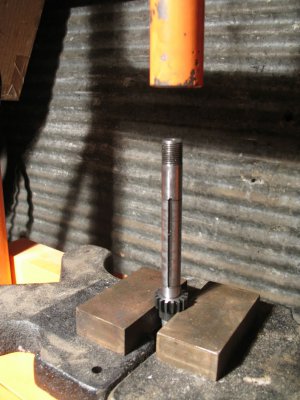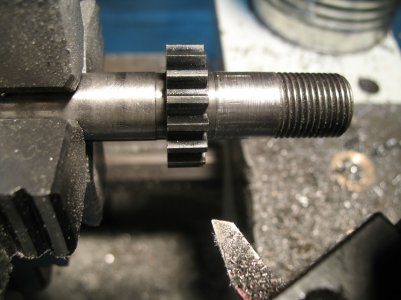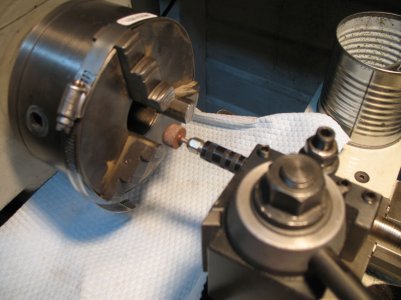Has it really been months? Well once you get something up and running who has time for forums!
Tim, I got a very good press fit on the gear and didn't worry about keying it in. I can happily report it worked fine. I have the same issues with the abc dial as well. A little adjustment and that is working fine as well.
I finally got some grease on the gear train as the manual says to lubricate it with and this quieted down the gears quite a bit. However the grease doesn't seem to stay on there too long and it just gets loud again.
Once I got the gear box fixed I was able to finally thread up my spindle plug gage. Then I commenced re-boring and threading the backplate that was on my 3 jaw. I was using a home made boring bar with an old 1/4" drill bit as a threading bit. That didn't go over too well with the cast iron. I was getting a crappy finish when I realized I had some 1/4" round hss that I picked up at harbor freight. I ground a new thread bit on that and finished up the threads. As soon as the spindle gage threaded in, I was done! Low and behold when go to thread the cast iron backplate onto the lathe, I realize that the hub is too short and the spindle nose is bottoming out against the chuck before it fully seats against the spindle shoulder. :angry:
So after all that effort to reuse the backplate it didn't work. Luckily I still had the backplate that came with the lathe and machined the snout on that too fit the 3 jaw. Mount the chuck and it looks to run very true. That is till I mount some stock and see quite a bit of run-out. From what I can tell the chuck itself is dead nuts on center so I think I have a jaw problem.
I probably attempted something stupid, but I got a big hose clamp and tensioned the chuck jaws, mounted my Dremel flexible attachment in a tool holder and attempted to regrind the jaws. I went through a few tries on this and just can't seem to get the slop out of the jaws. Seems like one chuck screw gets things on center better than the others but still not great. I haven't even attempted to measure the run-out because it's visibly noticeable. I might have to put this 3 jaw away until I can figure out what I'm doing wrong. So for now I'm still stuck dialing everything in on the 4 jaw. Ugh.
Some new issues have cropped up however. When I put the carriage back on I used the shims that were already on it. I've subsequently noticed a lot of slop, so much that I could lift the carriage a bit. I could fit a .016 feeler guage between the worst of the carriage clamps even after taking the shims out. So I ended up having to lap a bit of metal off the front carriage clamps to where I have about a thou of clearance. Now things are much tighter.
I'm starting to practice some knurling and I'm having issues with the carriage hand-wheel clutch. I had no idea how tight it should be when I put it together and with the amount of tension against the carriage from knurling I can't move the carriage without the clutch kicking in. I didn't want to overtighten so now I guess I have to figure out just how tight it should be.
In making my first morse tapers for the tail stock I've come to the conclusion that the taper is pretty trashed. It's grooved considerably. I was using high spot blueing to test the fits and couldn't seem to get the fit right. When I put the same taper in a brand new mt3 to mt2 drill adapter it was an almost perfect fit, so I realized it was my tailstock not my part. It's a minor issue since it still holds well enough but someday I'd like to replace the tailstock ram.
It should have been evident to me when I bought the lathe but if a lathe
looks like it has been abused, it probably means it
has been abused. I can say however that restoring this thing has been quite fun, I've learned so much, and because of it I know this machine inside and out. I'm not afraid at all to tear an assembly down the second it starts acting up because I know how it all goes back together. Not too mention that collectively I've probably torn down and re-assembled everything on this lathe at least 3 times. TAKE TONS OF PICTURES AND NOTES when you disassemble something like this!
Oh and pictures...
A few things are pictured, the fix of the tumbler bracket and replacement knob as well as the geared shaft fix and a shot of my lackluster jaw grinding setup.
